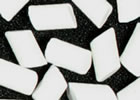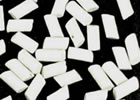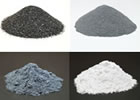Crazy Lace Agate
A favorite tumbling rough since the early 1960s.
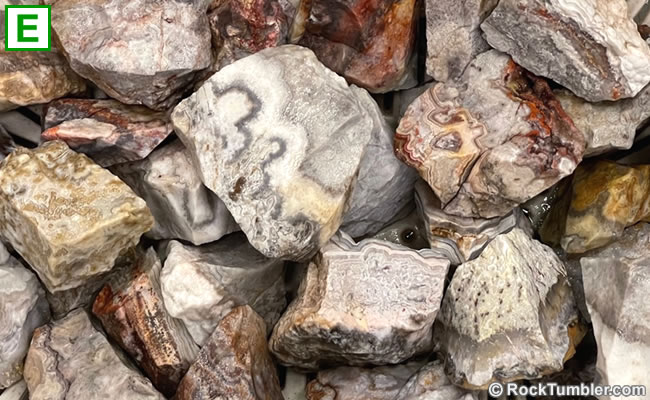
This photo shows a random two-pound pack of our Crazy Lace Agate tumbling rough, sprayed with water to reveal its full color. Click on the image for a larger view. Photograph by Hobart King.
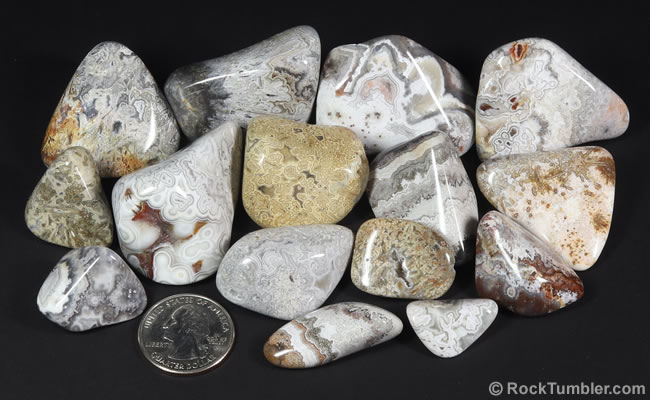
Crazy Lace Agate is famous for its "lace-like" banding and its ability to accept a high-luster polish. These tumbled stones made from Crazy Lace Agate rough that was tumbled by Adam Rittenhouse in a Thumler's A-R2 rock tumbler. Look at the intricate lace patterns in the stone and check out the super bright polish that Adam produced! Click on the image for a more detailed view. Photograph by Angela King.
Crazy Lace Agate Tumbling Rough
 ,
,  , and
, and  What do they mean?
What do they mean?
Size:
Mostly 1/2 to 2 1/2 inch piecesWhat Is Crazy Lace Agate?
"Crazy Lace Agate" is a marketing name used for a variety of banded agates mined in Chihuahua, a state in northern Mexico. It is best known for its extremely intricate banding that reminds the observer of a lace fabric.
Crazy Lace Agate has been a popular rock tumbling material since the first hobbyist tumblers were produced in the early 1960s. Its popularity and abundance across multiple generations make it one of the world's most widely-known agates.
This banded agate forms in veins and other subsurface cavities. It is banded because it forms as a succession of layers on the walls of the veins and cavities. Each layer accounts for one band in the agate's structure.
These cavities often contained mineral crystals that predated the agate. In these situations, the layers (bands) of agate were deposited as surface coatings on the walls of the cavity AND on top of the older mineral crystals.
Sometimes scatters or clusters of crystals were deposited on top of the most recent layer of agate, and then additional layers deposited on top of those as well. This is why the banding of Crazy Lace is so complex and crazy.
What Is Being Sold Here?
We are selling angular pieces of Crazy Lace Agate that mostly range in size between about 1/2" and 2 1/2" across (maximum dimension). This is a very hard material (Mohs 7), and we usually tumble it for two one-week sessions in coarse grit before it develops a rounded shape that we are happy with and decide to move on to medium grit. Sometimes we decide to give it a third week in coarse grit to give the stones an extra-nice shape. Your patience and willingness to spend extra weeks on the coarse grit step will be rewarded with nicer stones.
The Crazy Lace being sold here is mostly a semi-translucent to opaque white to gray color, with just a tiny amount of cream, yellow, orange, or brown coloring - in a few pieces. You will find some tiny vugs (small open cavities) in this rough. Sometimes they are lined with botryoidal chalcedony. Some are lined with drusy quartz (tiny well-formed quartz crystals).
You might find some patches of translucent to semi-transparent agate in some of your stones. These sometimes reveal a glimpse of those pre-dating minerals described above. They might be sprays of acicular crystals, mossy growths, or coarse crystals of carbonate or sulfate minerals. Crazy Lace always has hidden surprises - so please explore it with a magnifier before and after tumbling. (You are missing out if you don't do this!)
Very Hard and Tenacious
Agates are among the hardest and most durable materials that are commonly encountered in nature. They are composed of microcrystalline quartz with a hardness of 7 on the Mohs Hardness Scale. Agate has a superior tenacity that gives it durability in a rotary tumbler.
Crazy Lace Agate shapes slowly in a small tumbler, and to transform 2" pieces of angular rough into nicely-shaped tumbled stones, it will require at least two weeks of tumbling in coarse grit. The wait is worth it. Do an extra week if your stones still have an angular outline.
Crazy Lace Agate was one of the first materials that I tumbled in a Thumler's A-R2 tumbler that my father gave me in the 1960s. The fact that it has been readily available as a tumbling rough across the past several decades means that there must be a huge deposit (or many small deposits) of this material in northern Mexico.
Crazy Lace Agate - Tumbling Properties | |
| Marketing Name: | Crazy Lace Agate |
| Classification: | Quartz >> Chalcedony (microcrystalline quartz) >> Agate |
| Composition: | Microcrystalline quartz (SiO2) |
| Mohs Hardness: | 7 |
| Size: | Pieces of rough are 1/2 inch to 2 1/2 inches in size (measured across the maximum dimension). |
| Recommended Recipe: | We tumbled Crazy Lace Agate in rotary tumblers with good results using our "Tumbling Instructions for Jasper, Agate, and Other Hard, Tenacious Materials". A brighter polish might be obtained using a vibratory tumbler such as the Thumler's UV-10 or UV-18. |
| Recommended Polish: | TXP aluminum oxide |
| Tips for Success: | (1) If you are using a small tumbler with a barrel rotation speed of 80 RPM or higher, 2" pieces of Crazy Lace Agate are likely to be bruised while tumbling - and they will also bruise smaller pieces in the barrel.
(2) Many pieces of Crazy Lace Agate contain open cavities. These are often lined with drusy quartz crystals or botryoidal chalcedony. These cavities can be very interesting. But, these cavities are places where grit can hide. So, we highly recommend inspecting your stones after you have rinsed them thoroughly, but before they have dried, and flush any grit out of these cavities. We do that with a stream of water under a faucet or hose. (3) Some people do a burnishing step with Ivory bar soap after the fine grit step. They do this to help remove particles of grit from the cavities - to prevent grit particles from being present in the polishing step. We think this "clean-up step" is a good idea. |
| * Tumbling properties are for the stones being sold here. Stones from other sources may require a different procedure. If your material was sold as "tumbling rough" you should ask the vendor for tumbling instructions. | |
Seller's Comments:
We tumbled a few barrels of Crazy Lace using our "Tumbling Instructions for Jasper, Agate, and Other Hard, Tenacious Materials". These stones were tumbled start-to-finish in Thumler's rotary tumblers (A-R1 and A-R2). The rotary tumblers produced a very nice polish.
Two-pound packages of Crazy Lace Agate are made from a random grab of rough from our stock.
Will every piece make a perfect stone? No! This is a natural material and patches of below-tumbling-grade material occur in the deposit. Each piece of the material is not examined from every angle and under different types of light. Some below-grade material is not revealed until it is tumbled. So, we are letting you know to expect some below-tumbling grade material.
Will you receive any oversize? undersize? or "country rock"? Yes! The rough is sized by screening and some oversize and undersize stones always sneak through. Small pieces of country rock might also be found.
Some Crazy Lace is Fluorescent!
We noticed that some pieces of crazy lace agate fluoresce under UV light! We took a few photos to show you. Not all pieces are UV reactive; we chose the pieces with the brightest reaction to include in these photos. Please note that not all batches of this material will include UV-reactive pieces; if you purchase a bag of crazy lace agate, we cannot guarantee that any of the stones you receive will react under UV light. Additionally, we used a scientific-grade UV lamp to observe this fluorescence. The long-wave ultraviolet lamps or "black lights" sold in novelty stores will only have a weak effect.
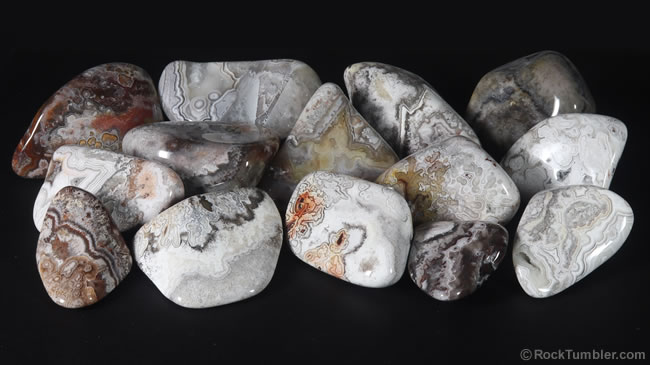
This photo shows some polished crazy lace agate under a "natural daylight" lamp. The rocks in this photo range in size from 1 1/4 inches to 2 inches along their maximum dimension. All stones were tumbled by Adam Rittenhouse. Photographs by Angela King.
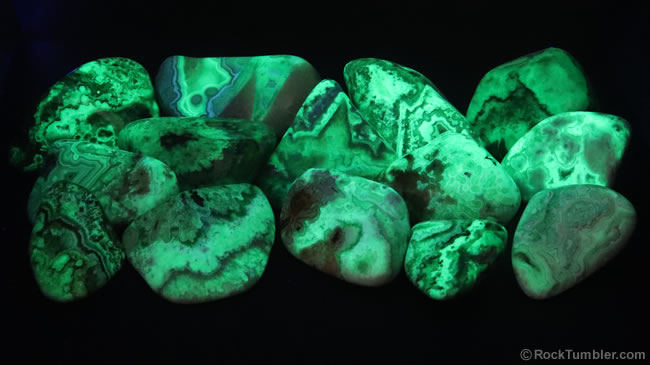
Here are the same pieces of crazy lace under shortwave UV light. Wow! They glow with a bright yellowish green fluorescence. As you can see, some of the bands glow brighter than others.
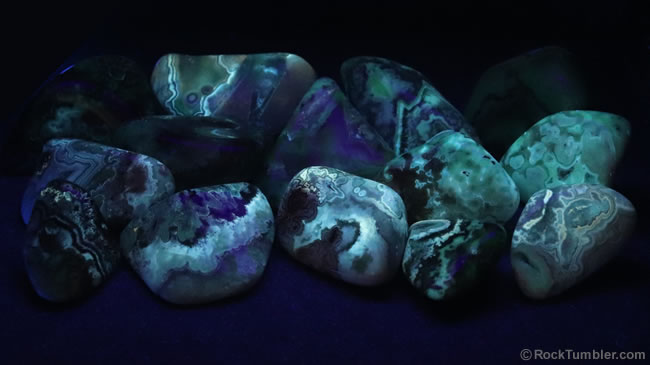
The same pieces of crazy lace under longwave UV light. The white areas of the stones have a subtle fluorescent glow. The purplish color seen in some pieces might be fluorescence, but is more likely a purple reflection of the UV bulb.
Customers also bought...
Large Ceramic Media

Small Ceramic Media

Standard Grit Kit



